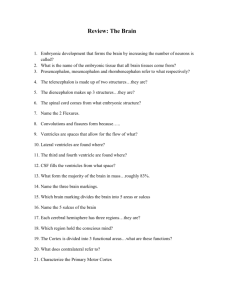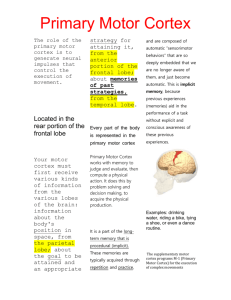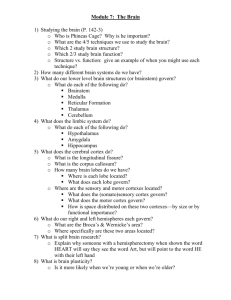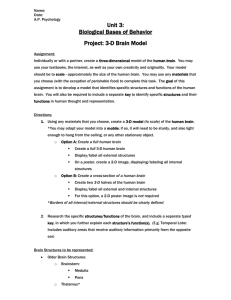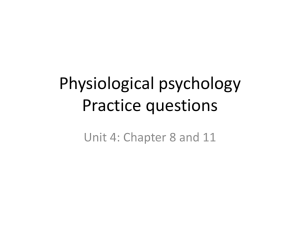Neuroanatomy
advertisement
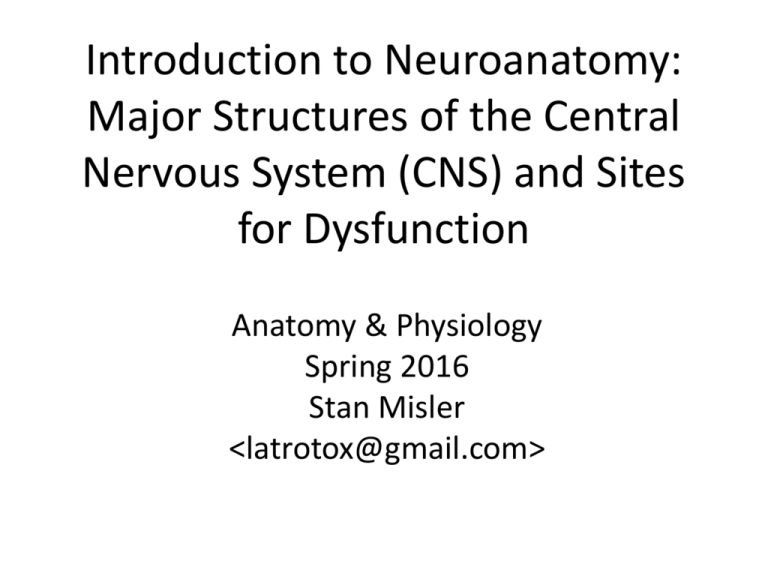
Introduction to Neuroanatomy: Major Structures of the Central Nervous System (CNS) and Sites for Dysfunction Anatomy & Physiology Spring 2016 Stan Misler <latrotox@gmail.com> Why study neuroanatomy? The brain is the basis for the mind and the soul. “The engine of reason and the seat of the soul“. Reality is not absolute but rather how regions of brain acquire and interpret features of the environment Physicians use history and symptoms of illness to track down types of brain disorders (epilepsy, stroke, blood collection, movement or sensory disorder including demyelination) and then use computerized tomography (CT or MRI) with functional imaging to carefully localize lesions prior to angiography for aneurysm, surgery or radiation treatments for tumor or epileptic focus, spinal tap in comatose patient. Computerized tomography: horizontal, coronal and sagittal section Computerized Tomography vs. Plain x-ray film Imaging skull but no brain tissue CT: Rotating x-ray tube and detector give cross-sectional slices with minimized problem of superposition, improved image contrast and way to record small differences in tissue contrast Magnetic resonance imaging of brain is more detailed than dissection of preserved brain after death Functional imaging (changes in regional bloodflow) localizes specific regions of activity and confirms cerebral hemispheric specialization CNS composed of nuclei, (collections of synapses or cell bodies = gray matter) + myelinated tracts connecting the nuclei = white matter Ascending tracts from spinal cord Through brainstem to cerebral cortex Descending tracts from cerebral cortex through brainstem to spinal cord Major landmarks of the central nervous system (CNS): spinal cord + brain (midsaggital section) Structure / Function correlates in CNS Spinal cord: stretch + withdrawal reflexes; stereotyped limb movements Brainstem: Neural ensembles in brainstem reticular formation coordinate reflexes and simple behaviors (crying & suckling) to keep baby alive (i) medulla oblongata: control of chewing, swallowing, digestion, breathing, heart rate; reflexes for sneezing, coughing & vomiting (ii) pons: connects cerebellum to cerebral hemispheres (iii) midbrain: eye movements, visual and auditory reflexes (superior and inferior colliculi) = info not sent to cerebral cortex (iv) reticular formation (diffuse internal network of brainstem) generates motor patterns Brainstem is origin of cranial nerves to head, face, ears and eye muscles Cerebellum: specialized motor movement processor : timing, coordination, precision (by moderating force and range of motion); learning of motor skills) (Brainstem + cerebellum = ancient hind brain as in frog) Diencephalon: (i) thalamus: sensorimotor waystation (all sensory input except olfaction + all motor outputs); conscious awareness may originate from bidirectional loops (cortex <-> thalamus) (ii) hypothalamus: regulates autonomic, endocrine, reproductive and visceral functions and aggression some via pituitary gland Telencephalon = cerebral cortex (wrinkled outer layer) deep structures = basal ganglia for precision of motor activity and limbic system = hippocampus for memory storage of facts and events (up to 2 years) + amygdala for autonomic and endocrine responses to emotional states + comparison of emotional experiences with past ones Motor cortex: initiation of skilled voluntary movements Sensory cortex: Incoming stimuli from thalamus e.g., lateral geniculate nucleus from retina to occipital cortex; Prefrontal cortex = executive function = social interaction and moral sense Association cortex: mixed modality Cortex is site of cognition: ability of brain to attend to, identify and act on complex stimuli (diencephalon + telencephalon = more modern forebrain beginning with reptiles) Limbic system Basal ganglia Structure /Dysfunction Correlates in CNS • • • • • • • • • • • • • • • Lower motor neuron injury -> flaccid paralysis Upper motor neuron (pyramidal system) injury -> spastic paralysis Basal ganglia injury -> movement disorders Cerebellum -> ataxia Ocular motor system injury -> loss of conjugate gaze Somatosensory system injury -> anesthesia and analgesia Visual system injury -> anopsia Auditory system injury -> deafness Gustatory and olfactory system injury -> ageusia and anosmia Cerebral cortex injury -> aphasia, agnosia and apraxia Limbic system injury -> antegrade amnesia and inappropriate behavior Hypothalamic injury -> vegetative and endocrine imbalance Autonomic nervous system injury -> visceral abnormalities Disorder of blood supply to CNS -> stroke Disorder of cerebrospinal fluid system -> hydrocephalus Cerebrum including cortex in detail Posterior gyrus = primary motor cortex for voluntary movement Secondary motor cortex for planning of sequence of motor commands Prefrontal cortex: Executive function Prospective short-term memory (motor act to be performed) In hippocampus consolidation of short to long term memory = comparison with older memories may take min to hrs Association areas of cortex for multitasking: simultaneous tasks reduce encoding (memorizing) and retrieving (recalling) Motor function Especially amygdala Somatosensory and motor homunculi Limbic system Basal ganglia Corticospinal (Pyramidal) and extrapyramidal efferent motor tracts Indirect control of spinal activity modulating posture, muscle tone and movement speed; activated by supplemental motor cortex Somatosensory afferent tract from spinal cord to cerebral cortex


